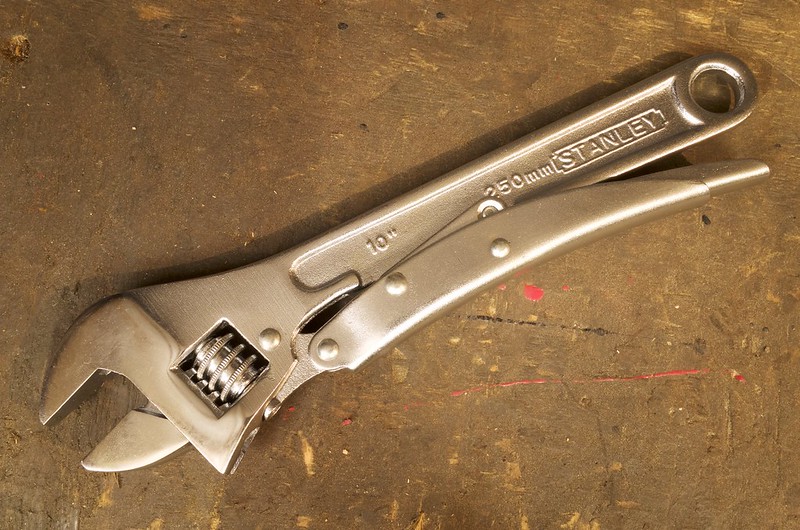Rhyolith
Established Member
I have found it not uncommon to be advised to not use adjustable spanners, even to the point of it being considered unprofessional to use them… but I still think adjustables are superior for most situations. Here’s why:
They fit tighter on the nut:
This is a common stated weakness of adjustables, but if you use them right (and they are well made) they can close tighter than a fixed spanner. This is particularly the case with old bolts and nut that have been worn to the point of not being a standard size anymore.
This concept is taken further with what it my opinion is the best general purpose spanner design. It can properly clamp the nut... it actually works so well you can get sufficient grip to tighten or remove a stiff thread via a round object (like a stripped bolt head).
 Stanley 10" Locking Adjustable Spanner (Locked) by Rhyolith, on Flickr
Stanley 10" Locking Adjustable Spanner (Locked) by Rhyolith, on Flickr
I is actually impossible for a fixed spanner to grip as well as this does.
Less time wasted looking for Tools:
You don’t have to spend time finding out what size the bolt or nut is and finding the right spanner. You just pick an adjustable thats roughly the right size and go. This is particularly beneficial with restorations of old things where you almost never know the bolt head sizes in advance.
Less Toolbox Space needed:
An adjustable will do the job of around 4 times their number in fixed spanners, the space this saves is not a small deal.
Lower Cost:
Quite simply because you need less of them.
This is not to say however that I don’t think fixed spanners have their place. If your going to be working with a lot of the same sized heads (like taking 100 of the same sized bolt out of something) then the time saved not having to fit on each one makes up quite a lot of searching time.
I’d also reach for a fixed spanner (particularly one with a ring) over and adjustable for working somewhere cramped, simple because they are generally slimmer and easier to use in many awkward spots.
Thats my 2 cents, I am will be interested to hear any thoughts
They fit tighter on the nut:
This is a common stated weakness of adjustables, but if you use them right (and they are well made) they can close tighter than a fixed spanner. This is particularly the case with old bolts and nut that have been worn to the point of not being a standard size anymore.
This concept is taken further with what it my opinion is the best general purpose spanner design. It can properly clamp the nut... it actually works so well you can get sufficient grip to tighten or remove a stiff thread via a round object (like a stripped bolt head).
 Stanley 10" Locking Adjustable Spanner (Locked) by Rhyolith, on Flickr
Stanley 10" Locking Adjustable Spanner (Locked) by Rhyolith, on FlickrI is actually impossible for a fixed spanner to grip as well as this does.
Less time wasted looking for Tools:
You don’t have to spend time finding out what size the bolt or nut is and finding the right spanner. You just pick an adjustable thats roughly the right size and go. This is particularly beneficial with restorations of old things where you almost never know the bolt head sizes in advance.
Less Toolbox Space needed:
An adjustable will do the job of around 4 times their number in fixed spanners, the space this saves is not a small deal.
Lower Cost:
Quite simply because you need less of them.
This is not to say however that I don’t think fixed spanners have their place. If your going to be working with a lot of the same sized heads (like taking 100 of the same sized bolt out of something) then the time saved not having to fit on each one makes up quite a lot of searching time.
I’d also reach for a fixed spanner (particularly one with a ring) over and adjustable for working somewhere cramped, simple because they are generally slimmer and easier to use in many awkward spots.
Thats my 2 cents, I am will be interested to hear any thoughts

































